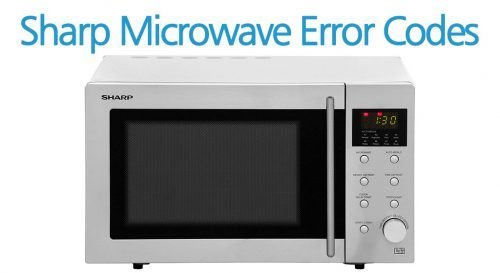
First things first, let’s demystify this E1 error code. Essentially, it’s your microwave’s way of signaling that something isn’t quite right. It’s like when your car’s dashboard light tells you to check the engine—it may not mean the car’s going to break down right away, but it definitely warrants some attention. Ignoring it might not be the best course of action, as it could lead to bigger issues down the road. So, what’s the deal with this code, and what should you do when it appears?
Understanding the E1 Error Code
The E1 error code on a Sharp microwave is primarily related to *sensor malfunction*. In simple terms, your microwave relies on various sensors to function correctly, kind of like how we use our senses to understand the world. When a sensor in the microwave is not working properly, the microwave can’t ‘understand’ what’s happening and warns you with the E1 code. It could be as mundane as a small sensor misalignment or as problematic as a part failing.
These sensors are crucial for maintaining proper cooking conditions. Imagine baking a cake without a temperature gauge on your oven—it would be tricky to get it perfectly baked. Similarly, when a microwave’s sensor acts up, it might affect how well it heats your food. So, while the E1 code might not scream emergency, it’s a hint that something is off and needs a little troubleshooting.
Ignoring sensor issues can lead to uneven cooking or even cause other components to wear out faster than usual. Therefore, addressing these issues sooner rather than later might save you some headaches (and unevenly heated meals) down the line. So, while it might be tempting to hit the dismiss button and move on, consider exploring what might be causing the E1 code.
Common Causes of the E1 Error Code
Now, you might be wondering what typically causes an E1 error. There are several reasons, but most of them boil down to a few common culprits. First, it could be due to *moisture buildup* inside the microwave. Just like how humidity can make your hair frizzy, excess moisture can mess with the sensors’ ability to function correctly. This is particularly common if you frequently cook steamy foods without letting the microwave air out.
Another reason could be a simple *power surge*. Think of it like a hiccup in your microwave’s electric flow. A sudden spike in electrical current can disrupt the sensors, triggering the error code. Lastly, it could be an *internal fault* like a worn-out part, similar to how a squeaky hinge might signal the need for some WD-40.
Checking these potential causes can give you a better idea of what’s happening. If it’s moisture, leaving the microwave door open after use can help prevent future errors. For power surges, using a surge protector might just be your microwave’s best friend.
What to Do When You See the E1 Code
Okay, so your microwave’s been hit with the E1 code, and now you’re at a crossroads. Here’s what you can do: start with the simple stuff. Make sure the microwave is clean and dry. A damp cloth and some elbow grease can do wonders in ensuring clear sensor paths. Also, double-check that the microwave is plugged in properly, and reset it by unplugging it for a few minutes, then plugging it back in.
If those quick fixes don’t work, it might be time to consider calling in reinforcements—like a technician. You may not love the idea of spending time and money on a service call, but remember, ignoring the issue could cost more in the long run. Sometimes, it’s better to address a small problem before it becomes a big nuisance.
Ultimately, taking these steps can help ensure your microwave continues to run smoothly. Don’t let the fear of an error code keep you from enjoying the convenience your microwave offers.
Preventing Future E1 Error Codes
As they say, prevention is better than cure. While you can’t always stop electronics from throwing a tantrum, there are some handy steps you can take to minimize the chances of the E1 error popping up again. Firstly, keep the microwave clean and dry. Moisture and food particles can mess with sensors, so after cooking, wipe down the interior to keep things spic and span.
Secondly, consider investing in a surge protector to protect against those unexpected electrical hiccups. This small gadget can safeguard not just your microwave but other appliances as well—think of it as an umbrella for your electronics.
Lastly, make it a habit to service your microwave occasionally. It’s like going for a dental check-up but for your microwave—regular maintenance can prolong its life and functionality. By taking these preventive measures, you increase the longevity of your microwave and reduce the chances of being greeted by the E1 code again.
At the end of the day, while facing the E1 error code might seem daunting initially, it’s mostly a gentle nudge to give your microwave a little TLC. Addressing the issue head-on can keep your food heating adventures on track without a hitch.